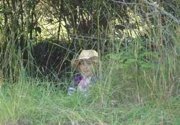Naturalist Intelligence
Students with naturalist intelligence are those who seem to be in love with the natural world. They like to spend time there, they thrive there, they are skilled and confident and comfortable there, and they learn best there — in short, they are nature smart.
Helping all students develop their "nature smarts" is a transformative gift we teachers can give to the world.

Many educators know of young students who know all there is to know about dinosaurs, butterflies, fish, rocks, etc. They have a deep interest in and fascination with something in nature and are driven to investigate and become an "expert" in a particular natural subject. These are the students who exhibit naturalist intelligence.
— Karen Roth, in The Naturalist Intelligence: An Introduction to Gardner's Eighth Intelligence
In 1983, Harvard University's Howard Gardner proposed a theory that there are multiple intelligences, seven in all. He has since added an eighth, the naturalist intelligence (and more recently, the "existential intelligence": the ability and proclivity to pose and ponder questions about life, death, and ultimate realities).
- verbal/linguistic intelligence or "word smart"
- bodily/kinesthetic intelligence or "body smart"
- logical/mathematical intelligence or "number smart"
- visual/spatial intelligence or "art/design/space smart"
- interpersonal intelligence or "people smart"
- intrapersonal intelligence or "self smart"
- musical/rhythmic intelligence or "music smart"
- naturalist intelligence or "nature smart"
- existential intelligence or "spirituality smart"

There are three main reasons for understanding multiple intelligences:
- teachers can extend their teaching repertoire to honour all the intelligences, and teach in ways that help students develop strength in all the intelligences
- the curriculum can be broadened to give value and status to all the intelligences (not just verbal/linguistic and logical/mathematical)
- every student's gifts can be validated by recognizing their unique pattern of intelligences (again, not just those gifted in literacy and numeracy)

Students demonstrate naturalist intelligence when they - are very comfortable outdoors
- are aware of their natural surroundings
- feel a definite sense of connection to the rest of nature
- have an affinity for natural habitats such as forests, deserts, oceans/lakes or streams, wetlands
- feel renewed by visiting these natural settings
- discriminate different flora and fauna
- recognize patterns and colours
- are good at sorting and classifying
- have keen observational skills and observe patiently
- feel satisfaction in learning names of flowers, trees, rocks and minerals, dinosaurs, birds, volcanoes, cloud formations, etc.
- enjoy exploring and touching outdoors, including "yucky things"
- understand and can explain natural phenomena
- show a sense for detail, noticing and delighting in the smallest of nature's gifts
- nurture living things, through gardening or taking care of pets or bringing home stray animals
- set up bird feeders and other feeding stations for animals
- choose to read books and watch programs about animals and ecosystems
- seek music related to nature
- make crafts and projects out of natural materials (using shells, driftwood, plant presses)
- like using equipment to find out more about the natural environment (butterfly nets, water and soil quality testing kits)
- readily follow cyclic patterns in nature such as tides, seasons, moon phases, and climate
- enjoy collections of rocks, leaves, flowers, shells, feathers, etc.
- name zoos, farms, wildlife parks, aquariums and pet stores as "special places" for them
- enjoy recreational activities in the outdoors, such as hiking, rock climbing, cross country skiing, camping, sailing, scuba diving, etc.
(adapted from Discovering the Naturalist Intelligence: Science in the School Yard, with thanks to Jenna Glock, Susan Wertz and Maggie Meyer)

Students show they are nature smart when they have a keen awareness of the natural world and phenomena, discriminate natural items like animals, insects, birds, fish, rocks, minerals, plants, trees, flowers, stars, [or] planets.... They often learn best when the content may be sorted and classified or is related to the natural world.
— Kagan Publishing, Multiple Intelligences Smart Card
Strategies for Teaching to the Naturalist Intelligence
Naturalist learning is experienced through
- relating
- discovering
- uncovering
- observing
- digging (literally and metaphorically)
- planting
- collecting
- sorting
- comparing
- displaying
Teachers can help their students develop or enhance their naturalist intelligence by providing learning experiences that encourage:


Falling in love with the earth is one of
life's great adventures. It is an affair of the heart like no other; a rapturous experience that remains endlessly repeatable throughout life. This is no fleeting romance, it's an uncommon affair, one unconstrained by age or custom, and strengthened rather than diminished through sharing. The more
one gives it away, the stronger it grows.
— Steve Van Matre, Institute for Earth Education
The point here isn't that schools should only teach to the naturalist intelligence. Indeed, we should be teaching to all eight (or nine) intelligences. But picture a school (and they exist already) where the natural environment becomes the classroom and Nature becomes one of the teachers. Even students who don't exhibit "nature smarts" will become more attuned and connected to the world around them. And as many wise people have said, we can't save something we don't love, and we can't love something we don't know. Don't we owe it to our students to help them develop their naturalist intelligence?
Return from Naturalist Intelligence to Transformative Nature Study
Go to GreenHeart Education Homepage
|

